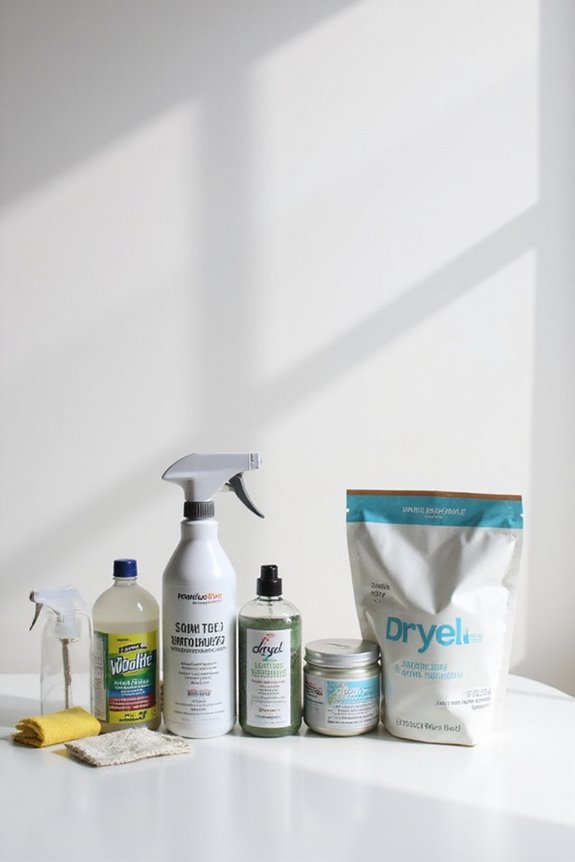We’ve all been there—coffee spills or ink marks on our favorite clothes are no fun! With the Dryel Pen, pretreating stains is super straightforward. First, identify the stain type and guarantee the fabric is clean and dry. Then, shake the pen, apply the solution to the stain, and let it sit for about 10 minutes. Just remember to dab gently, and don’t fret if it takes a second try. Curious about more tips?
Key Takeaways
- Identify the stain type to apply the appropriate treatment for effective results.
- Ensure the fabric is dry and free of loose dirt before application.
- Test the Dryel Pen on a hidden area to check for colorfastness.
- Apply the solution directly to the stain’s center and edges, allowing it to sit for at least 10 minutes.
- Dab gently instead of scrubbing to avoid damaging the fabric during treatment.
Understanding the Dryel Pen
When it comes to tackling stains, the Dryel Pen is like having a tiny superhero in your pocket. We love its convenient design, perfect for on-the-go pretreatment. With its portable size, we can easily toss it in our bags. The Dryel pen features a special formula that breaks down stain molecules, making cleaning during Dryel’s steam cycle more effective. It works wonders on delicate fabrics like wool and silk, so we don’t have to worry about damage. Plus, it’s super easy to use—just dab the tip on the stain. The Dryel pen benefits us by saving money on dry cleaning and allowing us to treat stains quickly. Trust us, it’s a game-changer for maintaining our special care clothes! Additionally, it’s important to ensure you’re using hypoallergenic formulations to minimize any allergic reactions while treating your fabrics.
Suitable Stains for Treatment
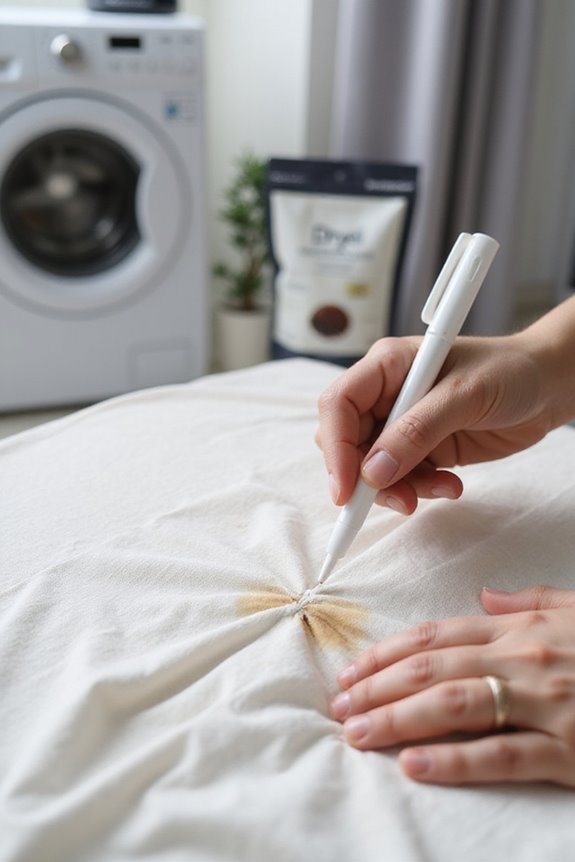
What kinds of stains can we tackle with the Dryel Pen? Luckily, this nifty tool is quite versatile! It works wonders on coffee stains, which always seem to sneak up on us during our morning rush. We’ve also found that it effectively removes ink marks from pens, a common mishap, especially for students. Grass stains from outdoor games? No problem! The Dryel Pen can handle those pesky marks that our kids bring home. And let’s not forget about lipstick stains; we all know how those can end up on our favorite tops. With the Dryel Pen in our stain-fighting arsenal, we can tackle these everyday challenges head-on, saving our clothes from permanent damage! Additionally, it’s good to know that the Dryel Pen can be particularly effective on coffee stains that are set-in as well, ensuring thorough cleaning.
Step-by-Step Pretreatment Process
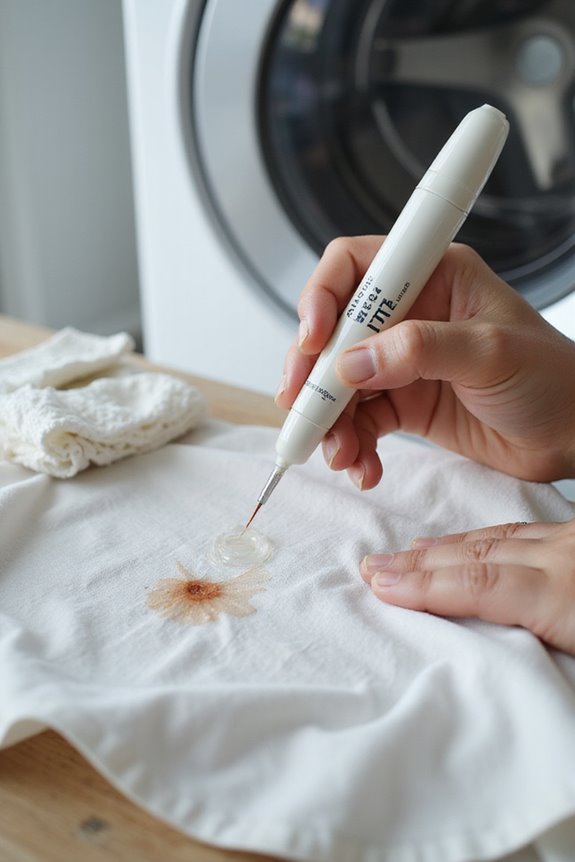
Let’s plunge into the step-by-step pretreatment process for tackling those pesky stains with the Dryel Pen! First, we need to focus on stain identification. Knowing what type of stain we’re dealing with helps us target our treatment effectively. Next, let’s prepare the fabric by removing any loose dirt or debris and ensuring it’s completely dry. We should also test the pen on a hidden spot to check for colorfastness. Now, we shake the pen and gently press the tip against the stain, applying just enough solution to cover it. After that, we let it sit for at least 10 minutes. Don’t rinse or wash yet; we’ve got more steps to go! Additionally, it’s important to consider fabric care instructions to ensure compatibility with the stain remover and prevent damage. Let’s keep going!
Best Practices for Effective Use
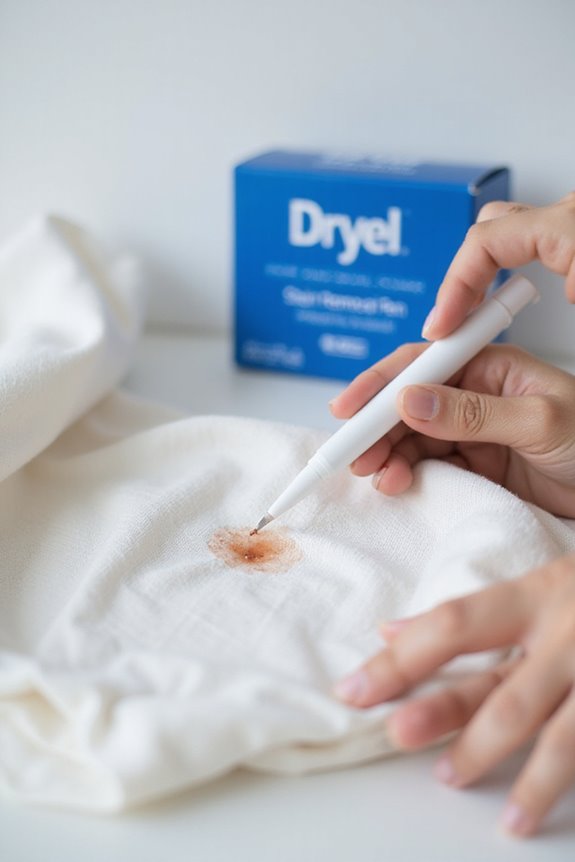
To get the most out of our Dryel Pen, we need to follow a few best practices that make stain pretreatment as effective as possible. First, we should apply the pen directly on the stain, hitting the center and edges. This guarantees even saturation. Timing is key—treat stains as soon as we spot them for the best results. After application, let it sit for a few minutes to break down the stain types. If the stain sticks around, a reapplication can help, but let’s avoid over-saturating the fabric. And remember, it works wonders on delicate fabrics like silk and wool. Additionally, always check for fabric safety to ensure compatibility with the material being treated. With these tips, we can tackle those pesky stains like pros!
Limitations and Precautions to Consider
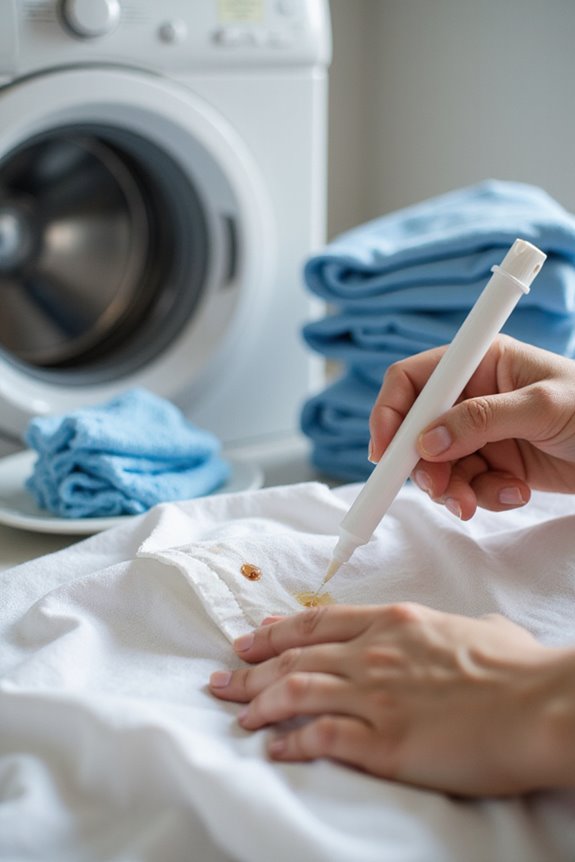
While using the Dryel Pen can be a game changer for tackling stains, we need to keep a few limitations and precautions in mind. First off, it works best on small, fresh stains—so don’t expect miracles on those old grease spots! It’s suitable for most dry-clean-only fabrics like wool and silk, but let’s steer clear of fur and leather. Always test for colorfastness before applying; we don’t want any surprises. When using it, dab gently—no scrubbing, please! Also, remember that it may not handle oil-based stains well. For the best results, apply it right away. And hey, keep it away from food and pets. We love them, but they don’t need a chemical bath! Additionally, consider using a blood stain remover spray for more effective treatment on tougher stains.
Frequently Asked Questions
Can Dryel Pen Be Used on All Fabric Types?
We can’t use the Dryel Pen on all fabric types due to compatibility issues. It’s effective for many, especially with stain removal, but let’s avoid sensitive fabrics like silk and leather to prevent damage.
How Long Does the Solution Last Once Applied?
Isn’t it ironic? We expect stain longevity, yet the solution’s effectiveness diminishes quickly. It’s best to act fast after applying the Dryel Pen to guarantee we get those pesky stains out promptly!
Is the Dryel Pen Refillable or Disposable?
The Dryel pen isn’t refillable; it’s disposable. While we appreciate eco-friendly choices, we’ll need to replace it after use. Fortunately, finding new pens is easy at local retailers or online.
Can I Use Dryel Pen on Upholstery or Carpets?
We wouldn’t recommend using the Dryel Pen on upholstery cleaning or carpet stains, as it’s designed for delicate fabrics. Testing it first is essential, but specialized products for carpets and upholstery are generally safer and more effective.
Does Dryel Pen Have an Expiration Date?
We can’t find a specific expiration date for Dryel Pen, but we should watch for expiration indicators like changes in smell or texture. Ensuring product longevity means storing it properly and replacing it when effectiveness declines.




